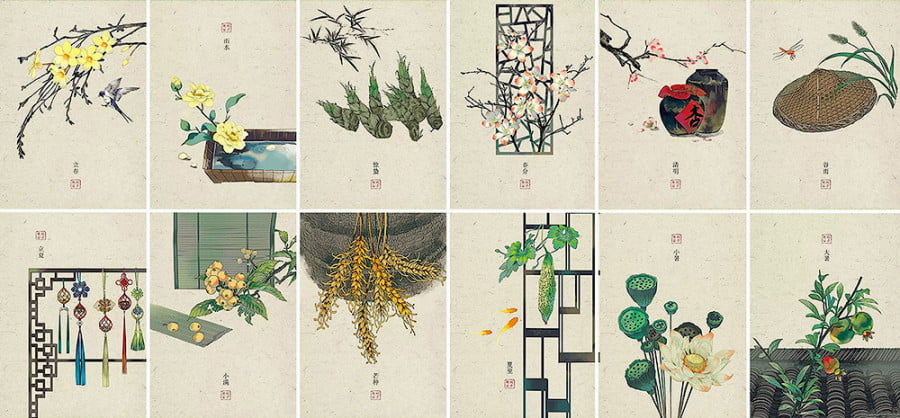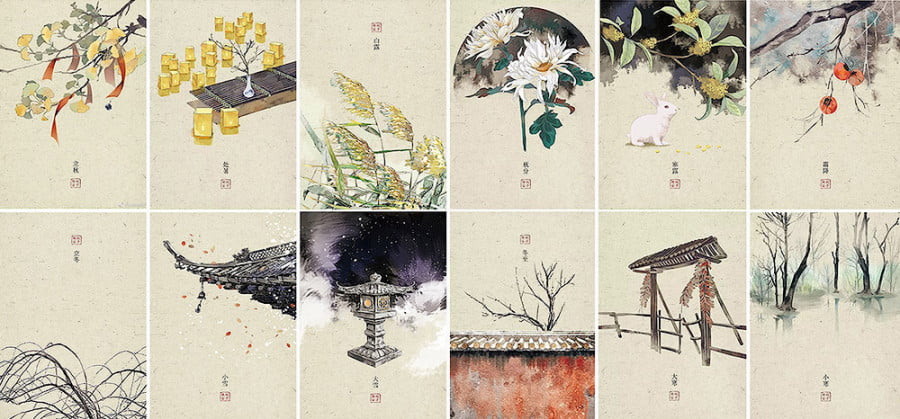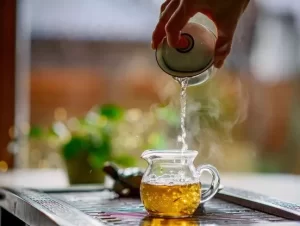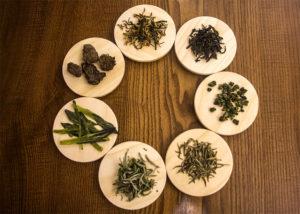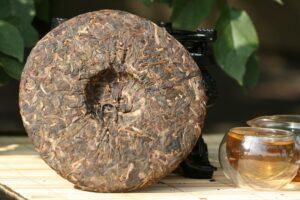In ancient times in Japan, according to the tradition borrowed from China, the year was divided into 24 periods, and in the natural annual cycle as many as 72 periods were distinguished, each of which has its own peculiarities.
The traditional calendar in Japan showed the changing seasons and changes in nature, and each of the 24 periods, called sekki, had its own name. The year lasted from the “beginning of spring,” rissun (early February), to the “great cold,” daikan. This division of the annual cycle was borrowed from China and is still used in East Asia.
Each of the 24 periods of this cycle was divided into three parts of about five days each, and there were a total of 72 short seasons in the year, called ko. They, too, were of Chinese origin and not quite suited to the peculiarities of the Japanese climate. In 1685, this system was revised by the court astronomer Shibukawa Shunkai. In their current form, these seasons poetically reflect the natural changes in Japan throughout the year. Their names describe how the earth wakes up, blooms, bears fruit, and then falls back into slumber. The table gives approximate dates, which may vary by one day in different years. In addition, there are no standard readings for the names of these 72 seasons-ko, so you may find other names for them in other sources.
立春 Rissyun (Beginning of Spring)
February 4-8 – 東風解凍 Harukaze koori o toku – East winds melt the ice
February 9-13 – 黄鶯睍睆 Koo kenkan su – Reedbills begin to sing
February 14-18 – 魚上氷 Uo koori o izzuru – Fish emerge from under the ice
雨水 Usui (Rainwater)
February 19-23 – 土脉潤起 Tsuchi no sho uruoi okoru – Rains moisten the earth
February 24-28 – 霞始靆 Kasumi hajimate tanabiku – Fogs begin to creep in
March 1-5 – 草木萌動 Somoku mebae izzuru – Grass breaks through, leaves on the trees
啓蟄 Keiichitsu (Insect Awakening)
March 6-10 – 蟄虫啓戸 Sugomori mushito o hiraku – Insects wake up and come out
March 11-15 – 桃始笑 Momo hajimete saku – Peach blossoms begin to bloom
March 16-20 – 菜虫化蝶 Namushi tō to naru – Pupae turn into butterflies
春分 Shumbun (Spring Equinox)
March 21-25 – 雀始巣 Suzume hajimete suku – Sparrows begin to nest
March 26-30 – 櫻始開 Sakura hajimate saku – Sakura blossoms
March 31-April 4 – 雷乃発声 Kaminari sunawati koe o hassu – The sound of thunder is heard
清明 Seimei (Purity and Clarity)
April 5-9 – 玄鳥至 Tsubame kitaru – Swallows arrive
April 10-14 – 鴻雁北 Kogan kaeru – Wild geese fly away
April 15-19 – 虹始見 Niji hajimete arawaru – The first rainbow appears
穀雨 Kokuu (Rains for cereals)
April 20-24 – 葭始生 Ashi hajimete shozu – Reeds sprout
April 25-29 – 霜止出苗 Shimo yamite nae izuru – Cold weather ends, rice sprouts
April 30-May 4 – 牡丹華 – Botan hana saku Peonies blooming
立夏 Rikka (Beginning of Summer)
May 5-9 – 蛙始鳴 Kawazu hajimete naku – Frogs begin to croak
May 10-14 – 蚯蚓出 Mimizu izzuru – Worms appear
May 15-20 – 竹笋生 Takenoko shozu – Bamboo sprouts
小満 Shoman (Small Saturation)
May 21-25 – 蚕起食桑 Kaiko okite kuwa o hamu – Silkworms eat mulberry leaves
May 26-30 – 紅花栄 Benibana sakau – Safflower blooms
May 31-June 5 – 麦秋至 Mugi no toki itaru – Wheat is ripening
芒種 Boshu (Bread Spreading)
June 6-10 – 蟷螂生 Kamakiri shozu – Mantis appear
June 11-15 – 腐草為螢 Kusaretaru kusa hotaru to naru – Grass rots and turns into fireflies
June 16-20 – 梅子黄 Ume no mi kibamu – Plums turn yellow.
夏至 Geshi (Summer Solstice)
June 21-26 – 乃東枯 – Natsukarekusa karuru – Nigella fades
June 27-July 1 – 菖蒲華 – Ayame hana saku – Irises bloom
July 2-6 – 半夏生 – Hange shozu – Pinellia sprouting
小暑 Shosho (Little Heat)
July 7-11 – 温風至 – Atsukaze itaru – Hot winds blow
July 12-16 – 蓮始開 – Hasu hajimate hiraku -. The lotus begins to bloom
July 17-22 – 鷹乃学習 – Taka sunawati waza o narau – Falcon chicks learn to fly
大暑 Taisho (Great Heat Wave)
July 23-28 – 桐始結花 – Kiri hajimate hana o musubu – Pavlovia is setting seed
July 29-August 2 – 土潤溽暑 – Tsuchi uruote mushiatsushi – The ground is wet, sweltering
August 3-7 – 大雨時行 – Taiu tokidoki furou Sometimes there are downpours.
立秋 Risshu (Beginning of Autumn)
August 8-12 – 涼風至 Suzukaze itaru – Cool winds blow
August 13-17 – 寒蝉鳴 Higurashi naku – Higurashi cicadas sing
August 18-22 – 蒙霧升降 Fukaki kiri matoo – Dense fogs descend
処暑 Shosho (Heat Cessation)
August 23-27 – 綿柎開 Wata no hana shibe hiraku – Cotton blooms
August 28-September 1 – 天地始粛 Tenchi hajimate samushi – It starts to get colder
September 2-7 – 禾乃登 Kokumono sunawachi minoru – Rice ripens
白露 Hakuro (White Dews)
September 8-12 – 草露白 Kusa no tsuyu shiroshi – White Dew on the Grass
September 12-17 – 鶺鴒鳴 Sekirei naku – Wagtails Singing
September 18-22 – 玄鳥去 Tsubame Saru – Swallows Fly Away
秋分 Shubun (Autumnal Equinox)
September 23-27 – 雷乃収声 Kaminari sunawati koe o osamu – No thunder rumbles
September 28-October 2 – 蟄虫坏戸 Mushi kakurate too o fusagu – Insects hide and burrow
October 3-7 – 水始涸 Mizu hajimate karuru – Water in the fields dries up
寒露 Kanro (Cold Dews)
October 8-12 – 鴻雁来 Kogan kitaru – Wild geese arrive
October 13-17 – 菊花開 Kiku no hana hiraku – Chrysanthemums bloom
October 18-22 – 蟋蟀在戸 Kirigirisu to ni ari – Crickets come under the door
霜降 Soko (Frostfall)
October 23-27 – 霜始降 Shimo hajimate furu – First frost
October 28-November 1 – 霎時施 Kosame tokidoki furu – Light rain at times
November 2-6 楓蔦黄 – Momiji tsuta kibamu – Maples and ivy turn yellow
立冬 Ritto (The Beginning of Winter)
November 7-11 – 山茶始開 – Tsubaki hajimate hiraku – Camellia Blossoms
November 12-16 – 地始凍 – Ti hajimate koruoru – The earth begins to freeze
November 17-21 – 金盞香 – Kinsenka saku – Daffodils Blossom
小雪 Shōsetsu (Small snows)
November 22-26 – 虹蔵不見 – Niji kakurate miezu – Rainbows disappear
November 27-December 1 – 朔風払葉 -. Kitakaze konoha konoha o harau – North wind plucks leaves
December 2-6 – 橘始黄 – Tatibana hajimate kibamu – Citrus tachibana begins to yellow
大雪 Taizetsu (Big Snow)
December 7-11 – 閉塞成冬 Sora samuku fuyu to naru – Colder, winter begins
December 12-16 – 熊蟄穴 Kuma ana ni komoru – Bears go into dens
December 17-21 – 鱖魚群 Sake no uo muragaru – Salmon go to spawning grounds
冬至 Toji (Winter Solstice)
December 22-26 – 乃東生 -Natsukarekusa shozu – Blackcap sprouts
December 27-31 – 麋角解 Sawashika no tsuno otsuru – Deer shed their antlers
January 1-4 – 雪下出麦 Yuki watarite mugi nobiru – Wheat sprouts under the snow
小寒 Shokan (Little Cold)
January 5-9 – 芹乃栄 Seri sunawati sakau – Parsley blooms
January 10-14 – 水泉動 Shimizu atataka o fukumu – Springs thaw
January 15-19 – 雉始雊 Kiji hajimeate naku – Pheasants begin to cry out
大寒 Daikan (Great Cold)
January 20-24 – 款冬華 – Fuki no hana saku Whitebush blooms
January 25-29 – 水沢腹堅 – Kiwamizu koori tsumeru Ice constricts streams
January 30-February 3 – 鶏始乳 – Niwatori hajimate toya ni tsuku Chickens begin to lay.
